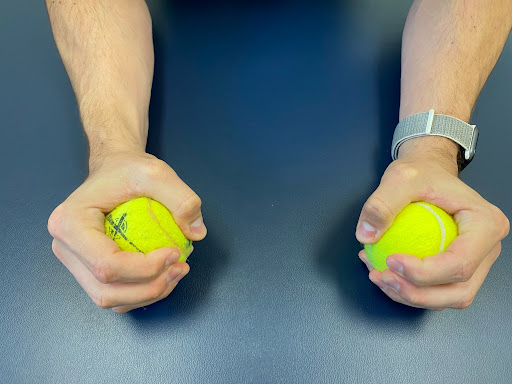Hypertension, or high blood pressure, was a primary or contributing cause of death for nearly 500,000 people in the United States in 2018 (1). Hypertension is defined as systolic pressure greater than 130mmHg or diastolic pressure greater than 80mmHg. The increased pressure forces the heart to work harder and places additional strain on arteries and veins. This puts you at risk for other health conditions such as heart disease and stroke, which are leading causes of death in the United States (1).
Common approaches for treating hypertension are medication and/or lifestyle changes. Unfortunately, these methods aren’t proving to be effective, with only about 1 in 4 adults (24%) with hypertension having their condition under control (2).
New research has shown that specific exercises and stretches can reduce blood pressure more effectively than traditional methods.
Check out Dr. Ryan Harley‘s demonstrations of the following exercises in this Instagram Reel:
Diaphragm Strengthening
One strategy to lower blood pressure is to strengthen your diaphragm, the primary muscle used in respiration. A 2019 study showed that systolic blood pressure dropped 10mmHg after participants performed 30 high intensity breaths, six times per week for six weeks (3).
Additionally, Silva et al. found that applying resistance during diaphragm strengthening was more effective at dropping both systolic and diastolic blood pressures (4). The BreatheEasy Lung Exerciser is only $30 and allows resistance to be adjusted. A device such as this is ideal for this type of training.
First, you may want to practice belly breathing and using your diaphragm appropriately. Check out this video for more information:
Isometric Exercise
Another effective method for reducing blood pressure is performing isometric muscle contractions. During an isometric contraction, the muscle remains under tension at a constant length and neither shortens nor lengthens. For example, performing a plank vs an ab crunch.
According to Buck et al. working a job that requires moderate to heavy isometric activity significantly lowered blood pressure in over 4000 men studied, regardless of age, affluence, or obesity (5).

- Squeeze a small ball for 2 minutes with mild to moderate pressure.
- Rest 1 minute and repeat 4 times. Do this 3 times per week for 8 weeks (7).
Stretching
Stretching has been shown to be helpful in lowering blood pressure as well. By stretching large arteries, like the femoral arteries in the legs and brachial arteries in the arms, improvements in blood pressure and arterial stiffness were seen (8). It’s thought that stretching these arteries produces tensile strain causing the vessels to release nitric oxide, a compound that decreases vascular stiffness.
Below are some options for stretching the brachial arteries, femoral arteries, or both.

- Doorway stretch – for upper extremities.

- Lunge stretch – for lower extremities.

- Reverse warrior – for upper and lower extremities.
- Hold stretch for 45 seconds and repeat 5 times (7).
Start Lowering your Pressure
Managing your blood pressure is just one piece of your overall health. If you’re someone with hypertension, try these novel approaches to lowering your numbers: strengthening your diaphragm, performing isometric exercises, and stretching your large arteries.
Thoughts and ideas by Thomas Michaud, DC. For more information, visit this website.
References
- Centers for Disease Control and Prevention. Underlying Cause of Death, 1999–2018. CDC WONDER Online Database. Atlanta, GA: Centers for Disease Control and Prevention; 2018. http://wonder.cdc.gov/ucd-icd10.html.
- Centers for Disease Control and Prevention (CDC). Hypertension Cascade: Hypertension Prevalence, Treatment and Control Estimates Among US Adults Aged 18 Years and Older Applying the Criteria From the American College of Cardiology and American Heart Association’s 2017 Hypertension Guideline—NHANES 2013–2016external icon. Atlanta, GA: US Department of Health and Human Services; 2019.
- Craighead D. Inspiratory muscle strength training lowers resting systolic blood pressure and improves vascular endothelial function in middle-aged and older adults. The FASEB Journal, 2019;33: 541.4.
- DaSilva C. Can respiratory muscle training change the blood pressure levels and hypertension? A systemic review with meta-analysis. Scand J Med Sci Sports, Feb 25,2021.
- Buck C, Donner A. Isometric occupational exercise and the incidence of hypertension. J Occup Med 1985; 27:370–372.
- Wiley R, Dunn C, Cox N, et al. Isometric exercise training lowers resting blood pressure. Med Sci Sports Exerc, 1992; 24: 749–754.
- Thomas Michaud. (2021). Novel Exercises and Stretches for Managing High Blood Pressure. https://cdn.shopify.com/s/files/1/2565/7146/files/ManagingHighBloodPressure.pdf?v=1623328666
- Bisconti, A, Cè E, Longo S, et al. Evidence for improved systemic and local vascular function after long term passive static stretching training of the musculoskeletal system. J Phys, 2020:1-22.
Share this Post

